#liferay7.4
Explore tagged Tumblr posts
Text
How To Upgrade To Liferay DXP 7.x to 7.4 Version: Step-By-Step Guide
Unlock the Secrets to a Smooth Liferay DXP 7.x to 7.4 Upgrade!
Is your organization planning to upgrade from Liferay DXP 7.x to 7.4? 🚀 Don't let the complexities of the upgrade process slow you down!
In our latest blog post, we dive deep into step-by-step strategies, best practices, and essential tips that will make your transition seamless. Whether you're managing the process yourself or with a team, this guide is your roadmap to success!

💡 What you'll learn:
Key features of Liferay DXP 7.4
Essential preparations before you upgrade
Common pitfalls to avoid
How to ensure zero downtime and minimal disruption
and much more…
👉 Read the full guide here: https://www.aixtor.com/blog/how-to-upgrade-liferay-dxp-7-x-to-7-4/
Don't miss out! Let’s make your Liferay DXP 7.4 upgrade a breeze! 🌐
#Liferay#LiferayUpgrade#Upgradetoliferay#DXP#UpgradeGuide#DigitalTransformation#TechSolutions#Liferay7.4#WebDevelopment#BusinessTech#UpgradeSuccess#TechTips
0 notes
Text
Upgrading to Liferay DXP 7.4?
Upgrading to Liferay DXP 7.4?
Our comprehensive guide breaks down the step-by-step process for migrating from older versions, whether you are moving from 6.x or 7.x.
Discover essential strategies for ensuring a smooth upgrade, including code rewrites, database modifications, and the adoption of modular design.
Learn how to enhance your digital experience and optimize your portal's performance with new features tailored for a mobile-first approach.
With careful planning and execution, you can streamline your upgrade and empower your customers with an improved online experience.
Dive into our blog for all the details and make your upgrade a success!
Read More: https://www.aixtor.com/blog/liferay-dxp-7-4-upgrade/

0 notes
Text
Deactivating and activating custom modules for a particular site in Liferay 7.4 (Part 2)
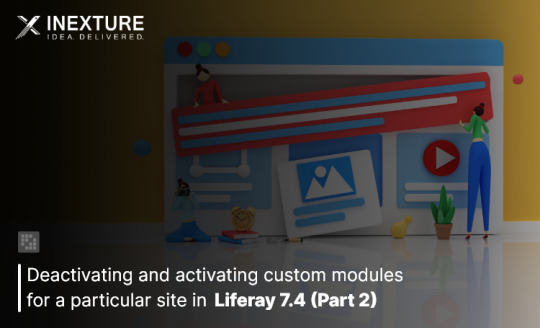
In previous part, we have created a panel module now we will create a service builder to store the values given from the user and to pass it to theme. Then we will create a theme to get this data and deactivate it from the site.
Creating a service builder (IntelliJ)
To store the state of the portlet on a particular side and to send this information in theme we need a service builder.
To create a service builder this are the following steps:
Go to File -> New -> Module
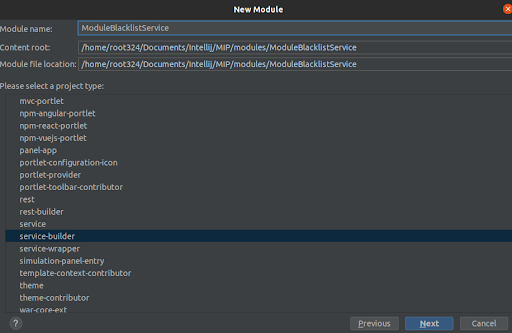
2. Update the service.xml file
<?xml version="1.0"?> <!DOCTYPE service-builder PUBLIC "-//Liferay//DTD Service Builder 7.4.0//EN" "http://www.liferay.com/dtd/liferay-service-builder_7_4_0.dtd"> <service-builder dependency-injector="ds" package-path="moduleblacklistservice"> <namespace>ModuleBlaclist</namespace> <!--<entity data-source="sampleDataSource" local-service="true" name="Foo" remote-service="false" session-factory="sampleSessionFactory" table="foo" tx-manager="sampleTransactionManager uuid="true"">--> <entity local-service="true" name="Portlet" remote-service="true" uuid="true"> <!-- PK fields --> <column name="id" primary="true" type="long" /> <!-- Group instance --> <column name="groupId" type="long" /> <!-- Audit fields --> <column name="companyId" type="long" /> <column name="userId" type="long" /> <column name="userName" type="String" /> <column name="createDate" type="Date" /> <column name="modifiedDate" type="Date" /> <!-- Other fields --> <column name="portletId" type="String" /> <column name="active" type="boolean" /> <!-- Finder methods --> <finder name="portletId" return-type="Collection"> <finder-column name="portletId" /> </finder> <finder name="groupId" return-type="Collection"> <finder-column name="groupId" /> </finder> <finder name="group_portlet" return-type="Collection"> <finder-column name="groupId" /> <finder-column name="portletId" /> </finder> </entity> </service-builder>
3. Update the local service implantation class
package moduleblacklistservice.service.impl; import com.liferay.portal.aop.AopService; import com.liferay.portal.kernel.exception.PortalException; import com.liferay.portal.kernel.model.User; import com.liferay.portal.kernel.service.ServiceContext; import com.liferay.portal.kernel.util.OrderByComparator; import moduleblacklistservice.model.Portlet; import moduleblacklistservice.service.base.PortletLocalServiceBaseImpl; import org.osgi.service.component.annotations.Component; import java.util.Date; import java.util.List; @Component( property = "model.class.name=moduleblacklistservice.model.Portlet", service = AopService.class ) public class PortletLocalServiceImpl extends PortletLocalServiceBaseImpl { public Portlet addPortlet( long userId, long groupId,String portletId,Boolean active, ServiceContext serviceContext) throws PortalException { User user = userLocalService.getUserById(userId); Date now = new Date(); long id = counterLocalService.increment(); Portlet portlet = portletPersistence.create(id); portlet.setPortletId(portletId); portlet.setActive(active); portlet.setCompanyId(user.getCompanyId()); portlet.setGroupId(groupId); portlet.setCreateDate(serviceContext.getCreateDate(now)); portlet.setModifiedDate(serviceContext.getModifiedDate(now)); portlet.setUserId(userId); portlet.setUserName(user.getScreenName()); portlet.setUuid(serviceContext.getUuid()); portlet.setExpandoBridgeAttributes(serviceContext); portletPersistence.update(portlet); return portlet; } public List<Portlet> getPortletByPortletId(String portletId) { return portletPersistence.findByportletId(portletId); } public List<Portlet> getPortletByGroupId(long groupId) { return portletPersistence.findBygroupId(groupId); } public List<Portlet> getPortlet(long groupId,String portletId) { return portletPersistence.findBygroup_portlet(groupId,portletId); } public List<Portlet> getPortlets(int start, int end) { return portletPersistence.findAll(start, end); } public List<Portlet> getPortlets(int start, int end, OrderByComparator<Portlet> obc) { return portletPersistence.findAll(start, end,obc); } public int getPortletsCount() { return portletPersistence.countAll(); } public List<Portlet> getPortlets() { return portletPersistence.findAll(); } }
After this you would be able to disable a portlet on a particular site. To disable:
Go to the ModuleBlackListConfiguration tab

2.Then go to action and uncheck the active status.

3.This will deactivate the module from the site.
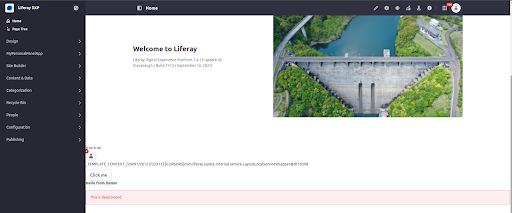
We will only be able to deactivate MVC modules which are present in widget panel.
Conclusion
Using this you would be able to disable modules on a particular site without affecting the rest of the site.
Originally published by: Deactivating and activating custom modules for a particular site in Liferay 7.4 (Part 2)
0 notes
Text
🚀 Elevate Your Digital Experience with Liferay DXP 7.4! 🚀
Discover the latest features empowering businesses to thrive online. 🌐 From low-code/no-code options to optimized digital experiences, Liferay DXP 7.4 is your key to maximum business outcomes. 📈 Here's a glimpse of what's new:

✨ 𝐃𝐚𝐭𝐚-𝐃𝐫𝐢𝐯𝐞𝐧 𝐈𝐧𝐬𝐢𝐠𝐡𝐭𝐬: Personalize customer experiences using user data, boosting conversions and loyalty.
🔍 𝐀/𝐁 𝐓𝐞𝐬𝐭𝐢𝐧𝐠: Test different variants of pages with clickable elements for enhanced user engagement.
🌐 𝐑𝐢𝐜𝐡 𝐃𝐢𝐠𝐢𝐭𝐚𝐥 𝐄𝐱𝐩𝐞𝐫𝐢𝐞𝐧𝐜𝐞𝐬: Seamlessly manage content, create engaging websites, and boost SEO with new tools.
🛒 𝐁2𝐁 𝐁𝐮𝐲𝐢𝐧𝐠 𝐄𝐱𝐩𝐞𝐫𝐢𝐞𝐧𝐜𝐞𝐬: Simplify and streamline the buyer journey, converting leads into loyal customers.
🤖 𝐋𝐨𝐰-𝐂𝐨𝐝𝐞/𝐍𝐨-𝐂𝐨𝐝𝐞: Unlock accessibility with adaptive media, collection display, and forms for non-technical users.
💡 𝐀𝐟𝐟𝐨𝐫𝐝𝐚𝐛𝐥𝐞 𝐏𝐥𝐚𝐧𝐬: Cost-effective solutions for quick, efficient digital experience launches and maintenance.
🌐 𝐈𝐧𝐭𝐞𝐫𝐜𝐨𝐧𝐧𝐞𝐜𝐭𝐞𝐝 𝐄𝐧𝐭𝐞𝐫𝐩𝐫𝐢𝐬𝐞: Centralized solutions for creating and managing digital experiences across touchpoints.
🔄 𝐌𝐮𝐥𝐭𝐢-𝐅𝐚𝐜𝐭𝐨𝐫 𝐀𝐮𝐭𝐡𝐞𝐧𝐭𝐢𝐜𝐚𝐭𝐢𝐨𝐧: Enhanced security with FIDO2 support for a simple and secure user experience.
🔗 𝐇𝐞𝐚𝐝𝐥𝐞𝐬𝐬 𝐀𝐏𝐈𝐬: RESTful web services for managing users, organizations, roles, and more.
📱 𝐑𝐞𝐦𝐨𝐭𝐞 𝐀𝐩𝐩𝐬: Register JavaScript files as Web Components, allowing front-end development separate from Liferay.
Upgrade to Liferay DXP 7.4 for future-ready improvements and stay ahead in the digital landscape.
Read More: https://lnkd.in/dsFND8Wp
hashtag
liferay7.4 #digitaltransformation #LiferayDXP #DigitalExperience #Innovation #BusinessTech #liferaylatestversion #LiferayDXPFeatures
#liferay7.4#digitaltransformation#LiferayDXP#DigitalExperience#Innovation#BusinessTech#liferaylatestversion#LiferayDXPFeatures
0 notes
Text
Deactivating and activating custom modules for a particular site in Liferay 7.4 (Part 1)

In Liferay 7.4 we can deactivate or activate a module for Liferay portal. This can be done using the components and app manager section from the control panel.
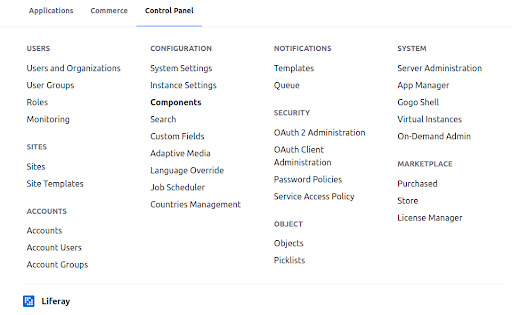
But Liferay doesn’t provide any feature to activate or deactivate a module for a particular site. As it can be a necessary thing when we have multiple sites and want to limit modules for that. To achieve this in Liferay we must create a panel module, service builder and theme. In the following part we will create a panel module to list all custom modules and to give user the access to disable a module on a particular site. In second part we will create a service builder and theme.
Creating a panel module (IntelliJ)
To show and let users perform action we need a module to display portlets and take user action.
To create a panel module this are the following steps:
Go to File -> New -> Module
Select Liferay Modules
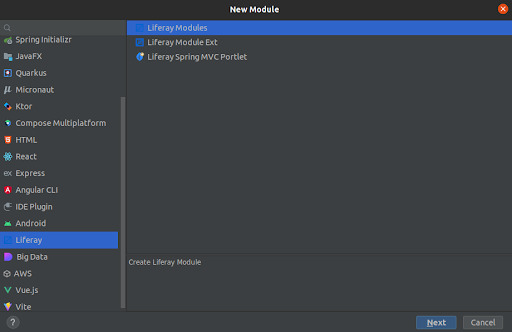
3.Give the name to the module and choose the project type panel app.
4.This will create a panel module.
5.After this to see all modules in view we need to add a render method that will give the list of all custom modules present on the portal.
The portlet will look like this:
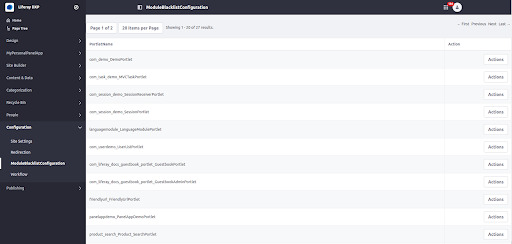
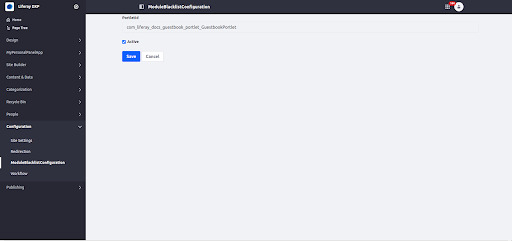
As we don’t have service builder and theme, we won’t be able to perform the active and deactivating functionality. Conclusion
We have created a module to list all the custom modules and let the users have access to activate and deactivate modules for a particular site. In part 2 we will create a service builder and theme.
Originally published by: https://www.inexture.com/deactivating-and-activating-liferay-objects/
0 notes